It’s Sunday and the weather is beautiful, so naturally I took the opportunity to sit at my computer and create some charts. Today’s topic: foreclosures.
First up is a chart of the ratio of sales to NODs, most recently discussed here but originally explained here. The idea is that measuring demand against the amount of potential must-sell supply provides a good read on the market’s health, or in this case the lack thereof.
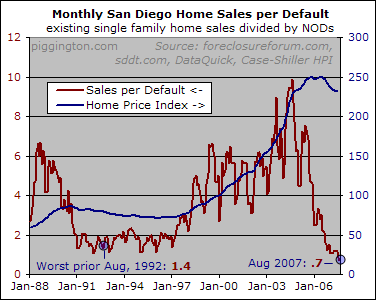
Yep, we’ve blown right through the "1" handle. Now, keep in mind that the sales here only include single family home resales (because that was the only historical data available), whereas the NODs are for all property types. This isn’t about the raw number but the comparison to past market conditions. Even with that in mind, though, the last reading was dismal — the very worst August reading of this figure in the 1990s housing bust featured twice as many sales per NOD as we saw last month. Not good.
Here’s a look at the same data on a log scale to give a better idea of the depths currently being plumbed:
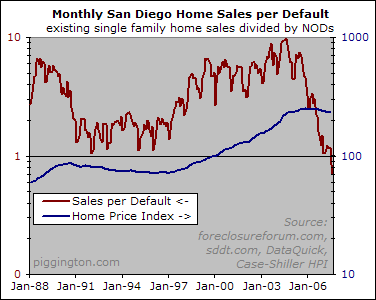
Here’s an update of a chart I did a while back showing how many NODs seem to be turning into NOTs (see below* for definitions if any of these terms are unfamiliar). As you can see, we’ve now reached an early-1990s level of NOD->NOT conversion, though with a much higher number of NODs, and there’s no sign of slowing yet.
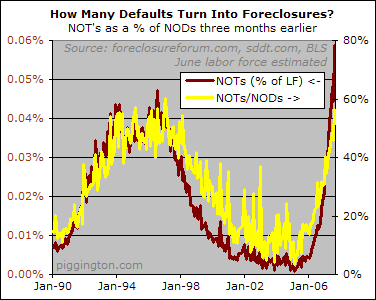
You’ve already seen this next one, but I include it for the sake of completeness. It is a chart of the number of NODs and NOTs filed each month since 1990. Each number is expressed as a percentage of the San Diego labor force in an attempt to account for San Diego’s growth over the years. (Labor force is used instead of population or household population because it is available monthly. Because the labor force is a higher percentage of the SD population now than it was in the early 1990s, the use of labor force actually slightly understates the ubiquity of NODs and NOTs).
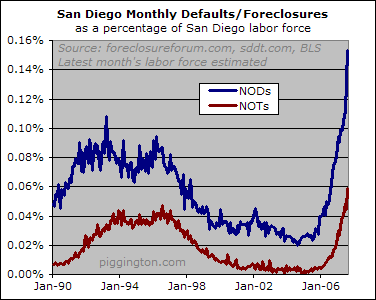
The idea for this next chart is stolen from a friend who is a foreclosure expert and occasional guest commenter here at the Econo-Almanac (he also provided the data in the charts). His idea was to stagger the data series’ to reflect the lag between NOD and NOT (about 3 months) and between NOT and REO (about 3 weeks). Given that NOTs feed into NOTs and NOTs into REOs, this technique gives the viewer an idea of what’s in store for the NOT and REO lines. Have a look:
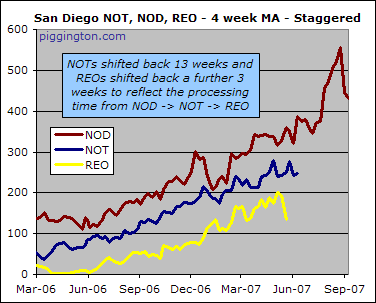
Again — not good. The chart clearly indicates that NOTs and REOs are headed north, especially given that more and more NOTs are making their way all the way through the process and becoming REOs. This latter trend has worsened enormously since last year:
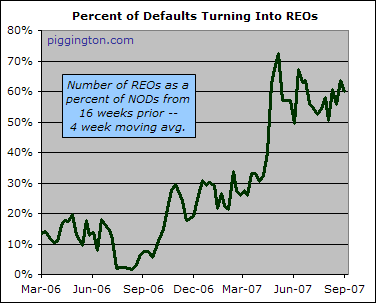
Once they become REOs, aka must-sell inventory, we are talking about real downward pressure on prices and not just ominous (if colorful) lines on charts. It’s a good thing the housing market is about to bottom (again), or else I might be worried.
* Acronyms explained:
- NOD – "Notice of Default" – The NOD marks the initial stage of the foreclosure process, in which a lender officially lets a borrower know that said lender couldn’t help but notice that said borrower hasn’t been paying his or her mortgage, and that if said borrower continues not to pay the mortgage, unpleasantries will follow.
- NOT – "Notice of Trustee Sale" – The NOT informs the still-delinquent borrower that the lender is going to auction off the borrower’s home or, if there are no takers, repossess the home itself. The law requires that there is a minimum delay of 90 days between the NOD and the NOT; and the NOT has to give a further 3 week notice before the foreclosure auction actually takes place.
- REO – "Real Estate Owned" – This terms is used to describe a property that has been repossessed by the lender (because there were no takers at the foreclosure auction) and is now for sale in the general market. Per the above bullet, there is a minimum of 3 weeks between the filing of the NOT and the auction; a property can only be REO after the auction takes place.

Really interesting charts.
Really interesting charts. It is helpful to keep building metrics for the market’s health.
I’ve been keeping an eye on statewide CA defaults using Realtytrac’s public data. These show huge increase in NOD since March. But, using a three month lag for NOT and four for REO, there is much more divergence than in San Diego. The NOT and REO (lagged) do not show as dramatic an increase as the NOD. At points I have read nebulous complaints about Realtytrac’s data. Anyone care to chime in with any specifics?
Thanks Rich, for the great stuff!
Rich,
I have to call you on
Rich,
I have to call you on your first graph (Monthly San Diego Home Sales per Default) because you are so meticulous in finding the errors in other people’s measurements. Using the single family resales as the numerator makes this graph less informative than you claim. You do point out that the raw number is not the point, but then try to compare the relative numbers from the previous bust to the current one. I would argue this is inaccurate because you have not stated whether the previous bust had the same mix of single family resales to actual REAL total sales as the current bust. If the values are different between the two time periods, then the comparison is invalid and misleading. I don’t have the data, but my suspicion is that there are more condos sold today as a percentage of total sales, thus more of the defaults are condos, creating a larger denominator today as compared to 15 years ago. This would make the stated comparison of 0.7 to 1.4 not a direct comparison and thus no opinion can be derived.
Other than that, the other presentations are great and I love reading this site for the latest, most thorough information on SD housing.
Studenteconomist, that’s a
Studenteconomist, that’s a good observation but in this case I don’t really agree that it is a big issue.
In August, SFH sales accounted for 68% of all DQ resales. (I am not counting new home sales here because we don’t know the split between sfh and condo).
First, I’m not convinced that it was so different back in the 90s. I haven’t seen any data one way or another. But let’s say for the sake of argument that SFH sales accounted for 80% of sales back in the 90s instead of 68%.
In that case, we’d have to normalize the current sales to increase by 18% (that being .68/.80, lemme know if I am getting the math wrong as this is quick and dirty). In that case, the sales per default number would change from .71 to .83 — still far, far less than Aug 1992. Even if sfh sales had account for 100% of 1990s sales, the normalized Aug 07 sales per default number would be 1.0 – still substantially worse than Aug 1992.
Also, while it could theoretically be an issue (though a small one, as seen above) if SFH sales aren’t an exact proxy for total sales, it doesn’t matter where the defaults came from. The point is that defaults are potentail must-sell inventory, and must-sell inventory is competing for potential demand regardless of provenance. Also, if the ratio of condo demand to sfh demand is higher now (still not convinced of that btw) then a proportionally higher availability of condo defaults should just even that out.
Rich
Elle –
1. Downtown
Elle –
1. Downtown courtroom steps as I understand it, though that’s not really my bag.
2. Don’t really know… but they must have known at minimum that they hadn’t been making their mortgage payments, right?
rich
Just anecdotal info here,
Just anecdotal info here, but when I was here during the last downturn in 1994, I was told by a couple of people not to buy a condo, because they were “nuclear waste” and could not be sold again. I.e., that nobody was buying condos.
If I had only known how cyclical this market is, I might have gone ahead and grabbed that early 4S Ranch condo that the saleslady so winsomely offered me… for $95,000.
>chirp<
Rich, thanks for the charts.
Rich, thanks for the charts.
One quick question: on the chart that compares the raw number of NODs with NOTs with REOs (time shifted and 4 week MA), I am surprised to see the down-tick, especially when you have a moving average, ostensibly to smooth things. Was there a dramatic decrease for some reason?
Fearful- it is a very noisy
Fearful- it is a very noisy series. It spiked up prior to Labor Day week (everyone trying to bust them out before the holiday?) and then down during Labor Day week itself (but down much more than is attributable to a single missing day).
I have not found these short term gyrations to be meaningful; the trend is what’s important.
Thanks,
rich
Realtytrac..Cali Aug REO is
Realtytrac..Cali Aug REO is 8571.
August Memo from Realtytrac is out. Their California numbers are mind-boggling. NOD went from 27k in July to nearly 42. REO’s went from 4444 in July to 8571. NTS held steady at about 7.5k.
Graham
Hi , What you say may
Graham
Hi , What you say may well be true but you will notice that the graph has called the decline in prices at virtually the identical level of the determining ratio.
As always enjoy reading your
As always enjoy reading your web articles and thanks for explaining NOD, NOT and REO
From a practical standpoint – Where do foreclosure sales generally take place for the City of San Diego? (I’m trying to get a sense of how many bidders usually show up for these sales)
Also, I’ve heard two stories now that a homeowner did not know their home was auctioned off until they got a knock on the door telling them to vacate. Is this possible? Or is the homeowner in deep denial about what’s going on. (there was an article in the Union Tribune yesterday that outlined one woman’s debacle)
Thanks,
Elle
Rich and all: There’s a
Rich and all: There’s a curious feature of the “NOT, NOD, REO 4-week MA staggered” chart, which perhaps you have a theory on? The lines appear approximately parallel, rather than proportional.
But why would there be an approximately constant offset between NOD, NOT and REO? That implies that there’s an approximately constant number of cases of NOD’s rescued before NOT, and NOT’s rescued before REO. What might explain that?
I realize that the subsequent graph “% defaults turning into REOs” looks at this same idea, and suggests “rapidly worsening proportion of people able to stave off REO”. I just thought the constant number who *are* able to stave off REO was interesting.
Graham
I think the point some of
I think the point some of you are missing is that we’re all attempting to use these different datasets and different methods of analysis to understand what is going on and where it’s going.
It is inevitable that most of these datasets are not optimized for the methods of analysis for which they’re being used; and that most methods of analyses are going to vary in both efficacy and consistency.
To a certain extent this boils down to the equivalent of working with what you have rather than what you wish you had. That’s why it’s okay to consider some of these graphs as depicting the forest and others as depicting the trees.
That is some nice data Rich.
That is some nice data Rich. I really think when this gets at it’s worst with increasing mortgage rates, lack of mortgage loans and a good price decline we could see that Sales/Default ratio get towards 0.1. That would make things really interesting.
Do the NOD’s include
Do the NOD’s include timeshares? I did a trial with Realty Trac and was astounded by the number of timeshares that come up. I don’t even think timeshares are financed, but I guess if you don’t pay the maintenance fee it can show up as a NOD.
As an aside, I don’t trust Realty Trac’s numbers. It seems like they are double counting (and triple counting) certain properties in order to get publicity. It does seem to be working for them.
All the rules have changed in
All the rules have changed in the last couple of months. Lending banks are now being held accountable for the trap they set, borrowing money they didn’t themselves have, while using loose and illegal practices in the process. The massive lawsuit against Wells Fargo / Wachovia, Indymac / OneWest bank, Citibank, Bank of America, JP Morgan Chase, GMAC…………..can actually, not only put a stop to your foreclosure, but also pause your house payments with no loss to you…………
https://sites.google.com/site/sueyourlendernow/